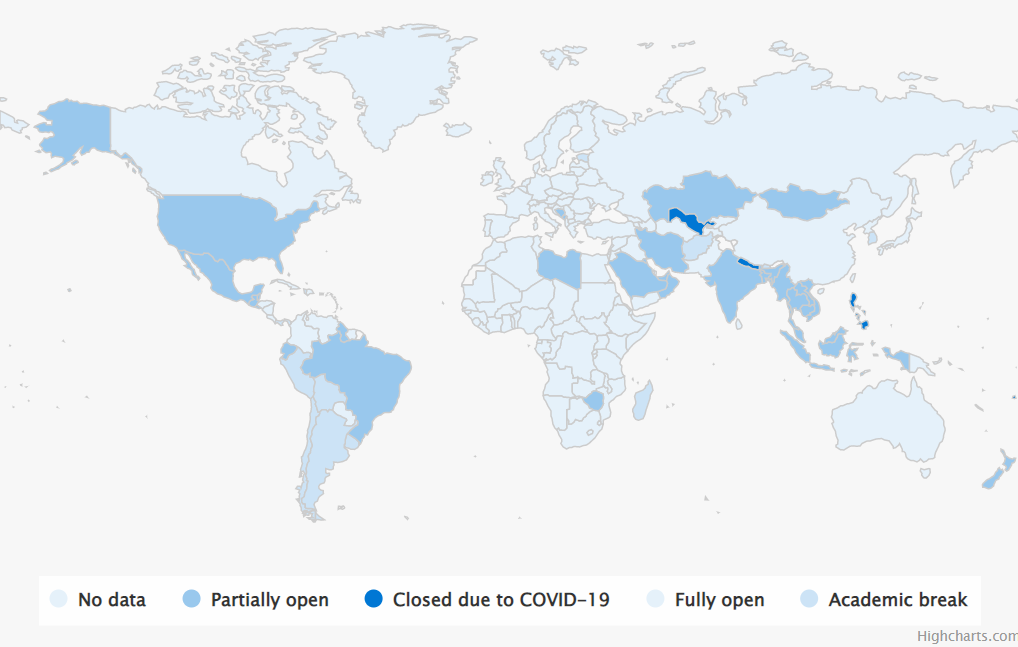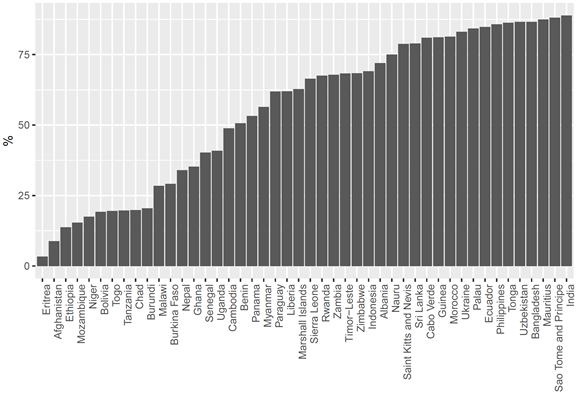By Alasdair Mc William, Head of Unit, Household Surveys and Equity, UNESCO Institute for Statistics
Education systems have been severely disrupted by the global coronavirus pandemic. Each country on average has experienced 40 weeks of full or partial school closures, with children losing over an estimated 2 trillion hours of in-person instruction. As of March 2022 - two years into the pandemic - education provision remains impacted by school closures, affecting over 40 million school aged children. Countries affected by closures are detailed in figure 1.
Figure 1: countries affected by school closures due to COVID-19

Measures that mitigate transmission of COVID-19 and its health impacts are crucial for getting children back into school and learning, whilst also keeping them, and the teaching staff and local communities, safe. Vaccination and behavioural measures such as social distancing are key. Infrastructure within schools, such as adequate handwashing facilities, ventilation systems, and physical space to support social distancing also have an important role to play.
Handwashing practices are recognised as a preventative measure for a variety of infectious diseases, including COVID-19. However, as figure 2 below illustrates, a sizable proportion of primary schools in many countries do not have basic handwashing facilities. This is the case among almost half of schools in the Least Developed Countries (LDCs). In some countries, such as Afghanistan, Ethiopia, and Niger the figure is less than 20%. In a 2021 survey of national authorities by UNESCO, the World Bank and UNICEF, 55% of country respondents said they had adequate resources and infrastructure (e.g., clean water, WASH facilities) to assure the safety of learners and school staff during the pandemic. Among low-income countries, just 6% of respondents reported that this was the case (according to date from Monitoring GEM Commitments Using the Joint Survey of National Education Responses to COVID-19).
Figure 2. Schools in lower income countries lack basic handwashing facilities
Percentage of primary schools with basic handwashing facilities

For COVID-19, evidence suggests respiratory transmission is comparatively greater than infection via touching contaminated surfaces, underlining the importance of physical distancing and mask wearing. As the virus can remain suspended in the air for several hours, adequate ventilation that quickly replaces air within indoor settings is increasingly recognised as a necessary means to help mitigate transmission of the virus.
Ventilation within schools and other building can be increased through passive means such as opening windows and doors, or through building layout and design. Active means such as fans and air filtration are also necessary, especially in colder climates or environments where there is not sufficient classroom space to allow adequate distancing . A study in the US state of Georgia, for example, found that COVID-19 incidence was 39% lower in schools with improved ventilation, and 48% lower in schools where air filtration systems were used, compared to schools that did not employ these strategies.
However, schools in many countries may not be able to sufficiently improve ventilation due to lack of electrical power. As figure 3 below illustrates, less than half of primary schools in many sub-Saharan African countries with data have access to electricity, and in some, less than 10% have access. Moreover, levels of access tend to be substantially lower in public schools than in private ones. Disparities in infrastructure between schools may, therefore, further entrench inequalities in educational outcomes, with poorer and marginalised children suffering the most.
Figure 3. Schools in many countries are unable to power ventilation systems
Percentage of primary schools with electrical connectivity, by sector

Developing adequate school infrastructure to mitigate disease transmission is not a quick or easy measure for many countries. However, with the threat of new COVID-19 variants and the potential for other future viruses, over the medium and longer term, investments in improving school facilities and infrastructure should be high on the agenda of educational policymakers and planners.xxx
Alongside this is the need to monitor the situation. Under Sustainable Development Goal target 4.a (to build and upgrade education facilities so that they provide safe and effective learning environments), the UIS, in collaboration with national authorities, continues to regularly collect data relevant to public health and disease prevention within schools. In the UIS March 2022 data refresh, data on the provision of basic services, such as handwashing facilities and electricity provision, has been updated for several countries.
Leave a comment